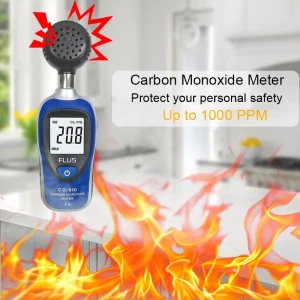Carbon monoxide is a colorless, odorless gas that can be extremely dangerous if undetected. It is produced by the incomplete combustion of fuels such as gas, oil, and wood. Exposure to high levels of carbon monoxide can lead to symptoms such as headaches, dizziness, nausea, and even death. This is why it is crucial to have a carbon monoxide detector in your home or workplace. In this article, we will delve into the inner workings of a carbon monoxide detector, how do carbon monoxide measure, and the importance of using a reliable carbon monoxide gauge.
A carbon monoxide detector, also known as a carbon monoxide meter, is designed with a high accuracy CO sensor, providing high accuracy, fast response, and stable readings. It is used to detect the presence of carbon monoxide in various applications, including poorly maintained furnaces, gas heaters, fireplaces, dirty or plugged chimneys, poorly maintained gas, oil, or kerosene appliances, and internal combustion engines such as automobiles, lawnmowers, and blowers.
The primary function is carbon monoxide measure the levels of carbon monoxide in the surrounding environment. This is where the carbon monoxide gauge comes into play, as it provides real-time readings of the carbon monoxide levels, allowing individuals to take necessary precautions if high levels are detected.

So, how does a carbon monoxide detector work? The detector operates based on a chemical reaction that occurs when carbon monoxide is present. Inside the detector, there is a sensor that contains a chemical solution. When carbon monoxide comes into contact with the sensor, it triggers a reaction that produces an electric current. This current is then measured by the carbon monoxide gauge, which displays the concentration of carbon monoxide in parts per million (ppm).
In the event of a carbon monoxide leak, the detector will sound an alarm to alert individuals of the potential threat. This is a critical safety feature that can save lives, as it provides an early warning system for the presence of carbon monoxide. Additionally, some detectors are equipped with digital displays that show the current carbon monoxide levels, allowing for continuous monitoring of the environment.
Therefore, when it comes to choosing a carbon monoxide detector, it is essential to select one that is equipped with a high-quality carbon monoxide gauge and measure. These components are integral to the overall functionality of the detector and ensure accurate and reliable readings. A high accuracy CO sensor is also crucial, as it directly impacts the precision of the measurements.
In conclusion
A carbon monoxide detector plays a vital role in safeguarding against the dangers of carbon monoxide exposure. The combination of a high accuracy CO sensor, carbon monoxide gauge, and measure enables the detector to effectively monitor and carbon monoxide measure levels, providing a crucial line of defense against this silent killer. By understanding how a carbon monoxide detector works and the importance of its components, user can take proactive steps to ensure the safety of their homes and workplaces.
